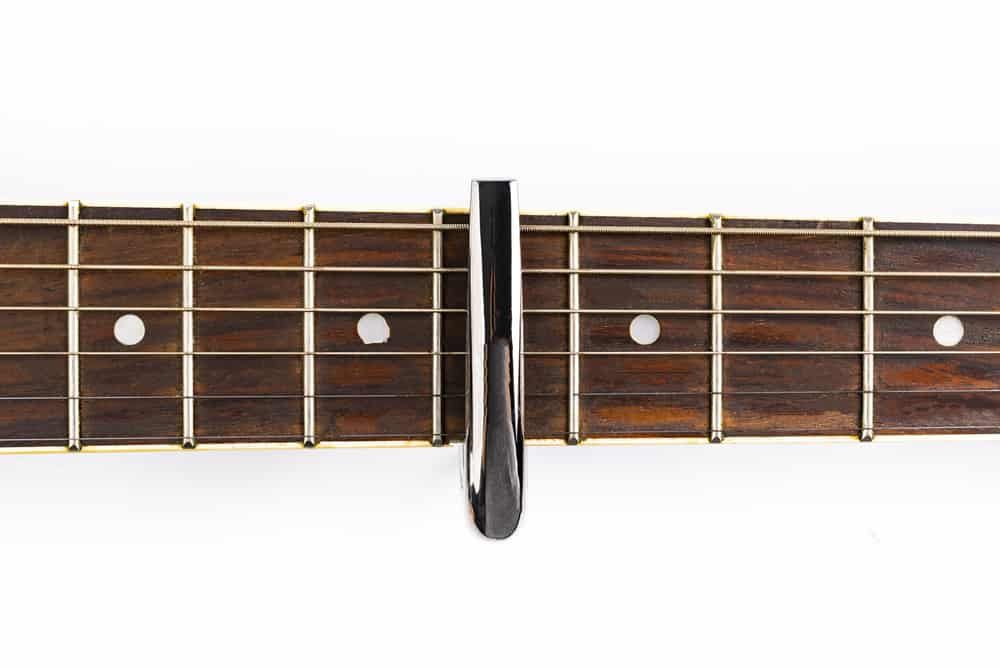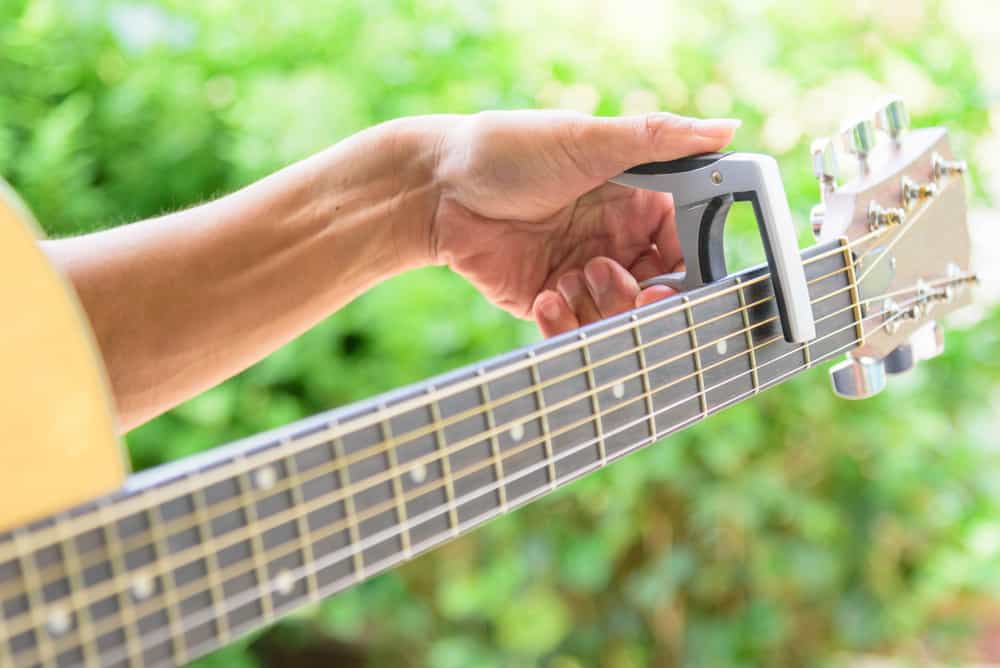A guitar capo can be a very complicated piece of equipment if you are a complete beginner. It’s easy to ignore them altogether as a guitarist because you can play most songs without ever having to use one. But if you’re planning on being a master guitar player, the day will eventually come when you will need a capo.
So what are capos, and how do we use them? We explain everything you need to know below, as well as a guide on using a capo for your guitar playing.
What Is a Capo?
A capo is a sort of clamp that applies pressure to the strings across a fret on the neck of your guitar. If you choose to use a capo, it makes the area you can play shorter and also raises the pitch, changing the key and chords as well. For every fret up the guitar’s neck that you use a capo, the pitch of the guitar will get higher and higher.
Capos are often likened to the nut of the guitar. The nut dictates the area where the strings stop vibrating and come to an end, located at the head of the instrument. So a capo is a kind of moveable nut, but instead of the strings passing over the device, it clamps down on them to shorten the strings instead.
By using a capo, you can change both the key and pitch of the chords you chose to play on your guitar. Any chord shapes you have learned can still be used, but you will be creating a different sound at a higher location on the instrument. The progression will no longer be of open chords, but they still sound good even when you use a capo. Playing a song with your capo guitar is basically just transposing the song, or changing the key and pitch of the music.
Using Your Capo
Now you know the basics of what a capo is, it’s time to learn how to use it. There are different types of capos, but almost all of them will serve the same purpose when it comes to playing chords. Discover the two most popular types of capos below:
- Cam-style capo – A capo like this will have a bar that clamps onto the strings, held in place by a cam-style clamp or screw that can be physically tightened to achieve the key you want.
- Rubber bar capo – Another popular capo style has a rubber bar placed on a material strap. You can tighten the strap around the back of your fret board, similar to putting on a watch. Some people refer to these as ‘cloth and toggle’ capos.
No matter what type of capo you want to choose, they all mostly do the same thing for your sound. What you choose all comes down to your own preference. The clamp design is often the most popular one because it can be taken on and off the strings quickly.
Applying the Capo
To being using your capo, you need to determine what fret you want to change from open chords to closed. Once you have made your choice, make sure that the capo is covering all of the strings along that fret. Then tighten it up to the desired pressure. And that’s it!
Once you have the capo applied to the guitar, play a few chord shapes on your strings and see how they sound. Each string should ring out clearly as you are playing without any fret buzz occurring. Be mindful of moving your capo as well. Try not to slide it up and down the guitar neck. Instead, you should remove it entirely from the instrument and then reattach it in the new play you want to play. This will help you to avoid wearing down your strings.
Other Uses for a Capo
There are multiple different uses for capos, and once you have mastered it for playing the songs you know, you can explore some of the other benefits it brings.
- Brighter sounds – Capos shorten the length of your fret board, so the tone of the instrument becomes brighter and higher. Any song you play will have a bit more shine to it because of the higher frequency helping it to ring out more.
- Changing key – Once you have mastered a progression using your open chords, you may feel it’s time to change things up a bit. A capo can be used to create a different sound during a song or can help suit a vocal range a bit better. You won’t need to learn how to play your instrument differently if this is the case. Just apply your capo.
- Avoid bar chords – A benefit that is useful for novices learning how to play guitar or for trickier songs. If a song has a tricky bar chord, transposing it by using your capo could mean you can play the piece without using your index finger at all.
Capo Charts
The key and tuning of the instrument will be changed depending on where you place your capo on the fret board. So if you play one of the chord progressions you have learned and then apply the capo to your fret, those chords will have changed key. They will all still be in key with each other, but the sound will have changed from playing it with open strings.
A capo chart will help any beginner get to grips on how this device will change the chord you are playing. We would recommend you find a good one and print it off to have on your music stand while you play.
Using a Capo FAQs
How do you put on a capo?
It will depend on the type of capo you purchase. Clamp capos are placed on the desired fret and then tightened until the chords sound right. Cloth and toggle capos are wrapped around the neck of the guitar and aren’t as easy to move when you’re playing as a clamp capo is.
How do chords change with a capo?
The tuning of your acoustic or electric guitar will change depending on where you put your capo. Putting a capo on any fret will change the chords. For example, playing an ‘A’ chord with the capo applied to the third fret would turn it into a ‘C’ chord. There’s a lot of different charts available online to see how chords will change when you use your capo.
Is it cheating to use a capo?
If you’re using a capo to impress in your technical playing skills, then it can be considered a form of cheating because you have assistance to hit certain chords. However, if you’re not relying on it for your technical skills and can show off in other areas, then there’s no harm in getting a little help with your chords.
What is a capo used for?
A musician can use a guitar capo to raise the pitch of their instrument, allowing them to play in a different key while still using the same fingers as you would when playing with the strings open. Effectively capos create a new nut on your fret at a higher pitch than the nut of the actual guitar.
How do I choose a capo?
It all depends on what kind of song you want to play. A clamp design capo will be better for you if you need to move up and down the guitar neck with ease. This is especially helpful for any guitarist wanting to play live, as you don’t have time to mess around with a cloth and toggle capo on stage. The best advice we can give is to invest in a capo that is of high quality, so you don’t end up damaging your strings.
Conclusion
Capos can be found in pretty much any music store you visit. Before you go ahead and get one, make sure you understand what they are, how they work, and which one would be suitable for your playing style.


